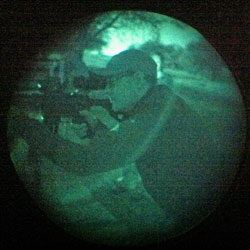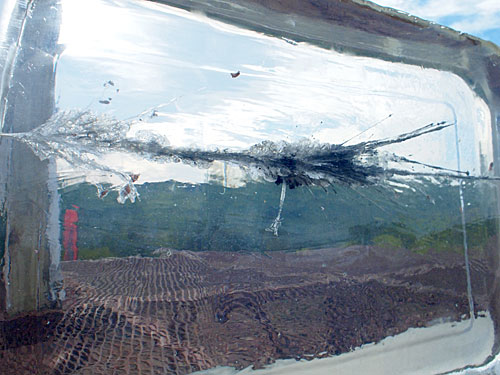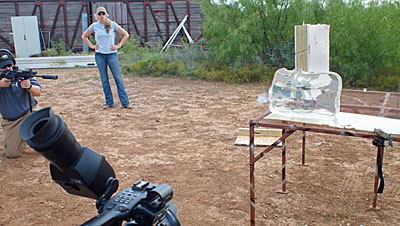
Once again, it’s way past midnight, probably between two and three a.m., and I’m kneeling in dirt, scanning a group of hogs though night vision. This is our third night out on hog patrol. I have half a magazine of .223 DRT penetrating frangible ammo in my suppressed Red Jacket Firearms AR-15. The small group of hogs is feeding in a large wheat field. I’m with SHWAT™ Co-Founder Stephen, DRT’s Nathan Dudney, and Red Jacket’s Jacob Herman. Everything is set for this last stalk of the last night. Well, almost everything…
If you’re going to play the tactical hog hunting game at night, you’d better be sure of your batteries. ATN supplied a variety pack of night vision and thermal gear. We used it for untold hours, first sighting in on the range, then just shooting for fun (hey, with piles of ammo laying around and steel targets waiting to be rung, wouldn’t you?), and then three all night hunts. Yes, we sighted in during the day, which may be a surprise to some, but we’ll save that for another article. The bottom line is that you need to know your battery life, and you need to know how fresh the batteries you picked off the shelf are.
Back to the hunt. The NVM14-3 night vision monocular mounted behind an Aimpoint T1 optic had exhausted it’s batteries. We’re less than 50 yards from the hogs with almost half a moon low in the sky. You can make out the hogs with your naked eye, but they are black, the dirt is dark, and the new wheat is barely a few inches tall. I can’t take that shot. “How ridiculous is this?” I’m thinking. I’ve been up too many hours, walked across too much red dirt to finish the hunt like this.
 Fortunately, our guide at the Spike Box Ranch near Benjamin, Texas is Eric. Thinking on his feet, Eric holds his unmagnified night vision binoculars to my eyes. Attached to my rifle’s picatinny rail is a Crimson Trace MVF-515 Vertical grip equipped with an IR (infrared) laser, visible only through night vision (NV) gear. I squeeze the grip, and see the dot though Eric’s almost steady NV.
Fortunately, our guide at the Spike Box Ranch near Benjamin, Texas is Eric. Thinking on his feet, Eric holds his unmagnified night vision binoculars to my eyes. Attached to my rifle’s picatinny rail is a Crimson Trace MVF-515 Vertical grip equipped with an IR (infrared) laser, visible only through night vision (NV) gear. I squeeze the grip, and see the dot though Eric’s almost steady NV.
Eric provides a three count and Nathan and I shoot. My prototype Red Jacket Silencer quiets the report of my rifle each time I pull the trigger, sending 79 grains of high tech ammo downrange. It’s hard to describe the exhilaration of the muffled report followed by the unmistakable sound of the bullet hitting its target – WHAP! I connect with a couple, and we harvest one. Stephen captures it all on video. It’s all smiles as the SHWAT™ Team wraps another hunt.
We did our best to thin the hog population at the Spike Box last week. Every pig we shot had this in common: it was hit with a DRT .223 55 or 79 grain bullet sent from a Red Jacket Firearms rifle. As SHWAT™ readers know, we’ve killed numerous hogs with this ammo, and like it. Keep reading, and you’ll start to understand why.
Not only did we hunt hogs using DRT Ammo, we got a demonstration shooting steel and gel. DRT refers to their patented bullets as penetrating frangible rounds. Yes, we shot them through a variety of Red Jacket Firearms suppressors without issue, as you’ll see in the video below.
Hang with me here, this is cool stuff. Here are the basics as they were explained. A typical bullet does damage in two ways: A) It pokes a hole; B) It rips soft tissue through what is often called the temporary wound cavity. DRT’s bullets also have a temporary wound channel. What’s different is the hole created, and it’s because the DRT bullet is different: Originally conceived at Oak Ridge National Laboratory, DRT has refined it to a copper jacket over a compressed blended powdered metal core. “We have created a bullet that penetrates like a lead hollow point in barrier or bone, but after encountering organic tissue the bullet completely returns back to powder creating a permanent wound cavity second to none. This also dumps 100% of the kinetic energy into the target, not wasting any with a pass through and also it is much safer for innocent bystanders,” says Nathan.

Here’s what’s going on when the bullet hits a hog: Instead of staying intact while poking a single hole as it passes through the hog’s organs, the jacket sheds and the core returns back to powder. The metal powder is so abrasive that is literally shreds through the organs or bone in its path.
The gel certainly looks that way, but there’s more to it than meets the eye. DRT engineers its bullets to penetrate a specific distance before it releases the powder. In the .223 rounds, it’s designed to penetrate two to three inches through biological targets, then virtually explode. We’ve seen Nathan shoot through barriers and get the same results.
 One more really import thing – if you’ve looked at a lot of “FBI” gel tests, you’re probably wondering why this gel used by DRT is so clear, versus the usual yellow hazed blocks you’re familiar with. DRT uses Permagel, and it’s designed to be clear, stable across a broader temperature range, and is readily reusable. But the much bigger story is that while it is calibrated and tested as 10% gelatin just like the “FBI” Knox gel, the Permagel only shows the permanent wound channel. So, yes, all you see in the picture is the permanent wound channel. When fired into Knox gel, the results are even bigger.
One more really import thing – if you’ve looked at a lot of “FBI” gel tests, you’re probably wondering why this gel used by DRT is so clear, versus the usual yellow hazed blocks you’re familiar with. DRT uses Permagel, and it’s designed to be clear, stable across a broader temperature range, and is readily reusable. But the much bigger story is that while it is calibrated and tested as 10% gelatin just like the “FBI” Knox gel, the Permagel only shows the permanent wound channel. So, yes, all you see in the picture is the permanent wound channel. When fired into Knox gel, the results are even bigger.
So, how does all that play out for the tactical hog hunter (or deer hunter, zombie hunter or whatever)? First of all, you don’t have to worry about dying of powdered lead poisoning if you eat the meat (it’s really optional on this destructive invasive species). The bullets are lead free and non toxic. Just don’t eat the organs where the powdered metal is left. As long as you make a proper ethical shot into the organ cavity, no meat will be ruined.
You start with a very accurate bullet. DRT’s ammo is often more accurate than other “Match Grade” ammo on the market. They require sub minute of angle (MOA – that’s less than one inch groups at 100 yards) accuracy from all their rifle rounds.
You still have to shoot accurately. It’s not a magic bullet, and we had hogs that made it out of the wheat fields under their own power as a result of less than perfect shooting. But, autopsies showed that if you do your part, the bullet does its part. Wounds were simply devastating.
 It’s hard to describe. Organs were literally pulverized. Spines weren’t just broken, they were demolished, just gone in sections. One hog had six vertebrate pummeled. I shot in the head the harvested hog we recovered in the included video. While there are people who will rightly state that the perfectly placed .22 at short range could kill a hog, the results of the bullet were remarkable.
It’s hard to describe. Organs were literally pulverized. Spines weren’t just broken, they were demolished, just gone in sections. One hog had six vertebrate pummeled. I shot in the head the harvested hog we recovered in the included video. While there are people who will rightly state that the perfectly placed .22 at short range could kill a hog, the results of the bullet were remarkable.
The entry was in the cheek of the pig, about half way back in in its mouth. It went straight back to the head. After traveling a couple of inches, the bullet opened and blew the jaw into pieces. If you felt that lower jaw, you’d say it felt like a bag of shattered bones. In the back of the hog’s head, the metal powder from the bullet’s core completely shattered the skull into hundreds of pieces, making complete mush from it. A standard bullet would go in one side and out the other, leaving a larger exit hole, but far less damage overall.
If you watched the video, you know the story doesn’t end with dead hogs as you might expect. It was the adrenalin rush of that onslaught, followed by a very brief pause. Then a herd of small hogs crashing through the brush not ten yards behind us gave us another brief rush! Tactical hog hunting is dynamic, challenging and fun. The hogs need to go, so get in the game and join us.
What’s your favorite ammo? Chime in on our Facebook page: www.Facebook.com/SHWATteam

